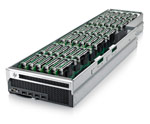HP Labs research powers project Moonshot, HP’s new architecture for extreme low-energy computing

From left to right: Senior researcher Jichuan Chang, HP Fellow Partha Ranganathan and researcher Kevin Lim.
HP today announces Project Moonshot, a program designed to advance extreme low-energy technologies for emerging web, cloud and hyper-scale environments that is substantially based on insights, research and technologies developed at HP Labs.
Project Moonshot encompasses a new development platform, a discovery lab and an industry ecosystem that will enable HP’s partners to bring cost and energy savings to large-scale, data-intensive computing.
The expected improvements are dramatic, notes HP Fellow Partha Ranganathan. “Our research suggests that for the kinds of workloads and applications that we’re now seeing in hyper-scale environments, we ought to be able to reduce energy consumption by 89%, use 94% less space and see costs that are 63% lower compared to traditional systems,” he says.
“The three parts of Project Moonshot together represent a paradigm shift in the industry,” Ranganathan suggests, “and they are all backed up by, and built upon, a decade of deep, strong, sustained research at HP Labs.”

An industry-first server development platform introduced by HP will help customers nearly eliminate cabling, switching and peripheral devices, in 94 percent less space.
A holistic approach
At the heart of the program is a novel, holistic approach to design for extreme computing environments.
The new solution uses state-of-the art low-power processors, for example, but they alone can’t deliver the kinds of efficiencies achievable by rethinking the entire data management infrastructure, says Ranganathan.
“It’s not just about the box anymore,” he argues. “It’s about shared chipsets, power, cooling, and storage – the entire fabric – and optimizing them all to work together. That’s really what Moonshot does.”
This insight came from many years of working closely with HP’s business units, says Jichuan Chang, who along with researcher Kevin Lim was a senior architect of the approach underlying the new technologies.
“People had started talking about Web 2.0 and we were trying to understand what that meant in terms of workload,” he recalls. “So we engaged with our colleagues in the businesses to understand the problem.”
The first significant fruit of their collaboration was the ‘microblade,’ an idea that the HP Labs team initiated and then announced to widespread interest in 2008. That breakthrough introduced the notion of using low-powered processors for the enterprise.
“Then, just as blade servers proved to be a fundamental disruption in how you design servers,” adds Ranganathan, “we started to think there was an opportunity to go beyond the platform to an overall solution.”

HP Redstone Development Platform is the industry’s first server development platform to feature extreme low-energy server processors that consume almost 90 percent less energy.
Multiple supporting innovations
Doing that required also determining the computing situations where a wholesale revision of conventional server architecture might be most effectively applied and creating tools that could calculate, for example, the power/performance tradeoffs that occur when you run servers on extreme low-energy microprocessors originally designed for mobile phones.
In the case of low-power processors, the HP Labs team were able to show that they could be deployed in servers with unparalleled density thanks to their ultra-small form factor, that they would cost significantly less and that, in specific situations, they would use a fraction of the power compared with traditional x86 servers.
Along with determining the most promising low-power processor architectures, HP research helped identify new application uses and optimization opportunities for this new generation of low-energy servers. Many of the benchmarking tools and calculators they created will be available to HP customers in the new Discovery Lab for precise application testing and selection.
“HP is unique in having in HP Labs an innovation engine able to build and maintain an industry-leading research portfolio like this,” says Prith Banerjee senior vice president of research at HP and director of HP Labs. “We see Moonshot as just the first in a series of advances that you’ll see emanating from this very strong pipeline of research.”
The next target for HP’s Intelligent Infrastructure Lab will be to combine the vision underlying Project Moonshot with other recent HP innovations such as photonic interconnects and memristor-based memory.
“That will create a game changing nanostore design,” Ranganathan says. “We think that too will really disrupt the market and we’re very excited about that as well.”